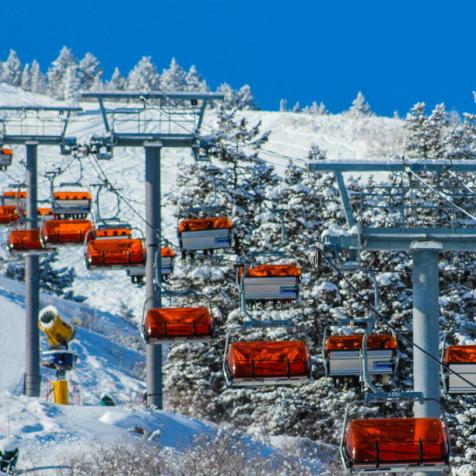
Company Details
Salt Lake City
Founded: 1892; in Salt Lake since 2002 merger with Garaventa
Privately owned
Employees: 130
CEO Mark Bee is steering the leading chairlift manufacturer into other transportation markets.
In 1892, Doppelmayr started as a blacksmith shop in Austria. It installed its first rope tow for skiing in the 1930s and today is the leader in uphill transportation at ski resorts worldwide.
But it remains true to its roots in more ways than one. "It's still family-owned," says Bee.
Bee runs Doppelmayr's U.S. facility, one of six in the world. The company's U.S. operations were in Golden, Colorado, before the merger with Garaventa, a Swiss company. Today they have 130 full-time employees in Utah, and staff numerous seasonal employees on installations around the country.
The current ski business, which accounts for about two-thirds of Doppelmayr's sales worldwide, is split between high-speed and fixed-grip chairlifts. The former can cost $10 million installed while the latter starts around $1.5 million. Doppelmayr also has a healthy service and parts business, as about 60 percent of about 3,500 chairlifts in North America are one of the company's many brands.
The Salt Lake facility specializes in lift towers and other steel structures as well as low-voltage control systems, while other facilities supply other specialized parts when the installation calls for it. "For fixed-grips, we do everything in Salt Lake," says Bee.

Dopplmayr's market is increasingly diverse. Besides ski lifts, the company has moved into public transportation and amusement parks with a people-mover that connects the airport and the train station in Oakland, California, and the Harry Potter-themed Hogwarts Express at Universal Studios Orlando. Over the years, the company has done numerous public transportation projects in Las Vegas, Portland, and South America.
The $170 million Oakland project spans three miles, while Hogwarts Express only covers 2,400 feet. Both look like trains, but they are both technically cable-pulled funiculars. "It looks like a steam engine, but it's actually a funicular pulled by a wire rope," says Bee of Hogwarts Express. "It serves as transportation, but it's also a show. It's a ride in itself." The lines were 10 hours long when it opened in summer 2014. "It's incredible how popular Harry Potter is."
Harry Potter aside, public transportation "is becoming a more important part of our business," adds Bee. Gondolas are very effective in cities, he adds. "A gondola can fly over streets and parks -- it's hard to fly over private property with a train."
In the more cyclical chairlift business, the biggest project in the last year was replacing the Centennial chairlift at Beaver Creek with an innovative design that alternates between chairs and gondola cabins. "It's a very high capacity lift -- 3,400 people an hour," says Bee.

In Utah, the company has "essentially 100 percent” of the market and has the contract for the gondola and two lifts at the upcoming interconnect of Park City Mountain Resort and Canyons Resort, which will create the largest ski resort in the U.S. for the 2015-16 season: 7,300 skiable acres in all. "It's going to be big," says Bee.
It's also the company behind the iconic tram at Jackson Hole and the Orange Bubble Express at Canyons, and increasingly installing other cutting-edge lifts with windshields, heated seats, and loading carpets that can increase a fixed-grip lift's capacity by 20 percent.
Doppelmayr's U.S. ski lift business has dipped since the Wall Street crisis of 2008, but money woes have been compounded by low snow in Tahoe and the Rockies in recent years.
In 2014, diversification was especially critical. "It's fortunate we had other projects," Bee says. But 2015 "is looking better” for the ski business. Besides the Park City work, Doppelmayr is replacing Chair 4 at Vail Mountain after the 2014-15 season.

Challenges: "For us, one challenge is to meet demand in a fluctuating market," says Bee. "It's very up and down, but you want to deliver what people want when people want it. At the same time, we want to run very lean and with low inventory."
Bee says the lead time from contract to completion can be as short six months. "We feel very fortunate to get an order in December." Getting approval to build lifts from municipal, state, and federal agencies is another challenge. "It seems to take longer and longer," says Bee. "It puts more pressure on our already short cycle."
Opportunities: Many of the 3,500 lifts in the U.S. and Canada are well past their prime. "Half of the lifts in North America are 30 years old or more," says Bee. "We should be selling two to three times what we're selling now."
Another catalyst: Cheap oil makes travel and skiing more affordable. "We think falling oil prices will be good for us," says Bee. "Plus, when the oil and gas industries are booming, it's harder to find welders."
Needs: "My top three are snow, snow, and snow," says Bee. "It's much easier to sell a ski lift when the parking lot is full. And there's still nothing like Monday Night Football when it's snowing in Denver."
Then there's always a need for talent with a diverse skill set who want seasonal work -- or "guys who want to work extremely hard in the summer then get the winter off. "It's unique compared to most contracting businesses," says Bee, noting needs for electricians, helicopter pilots, and structural workers. "Most of our guys who go to a project site have the ability to do all of those things."

